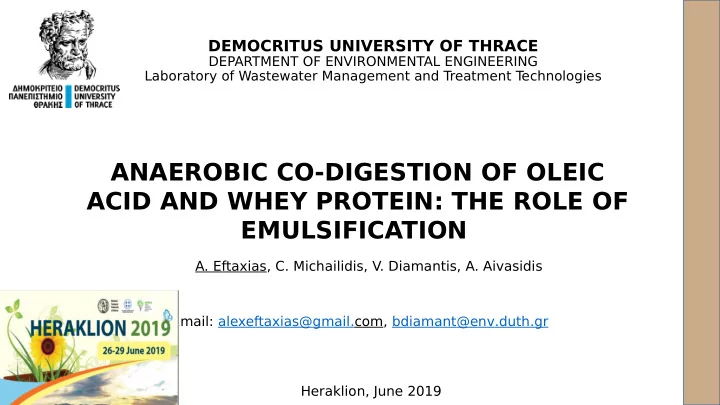

DEMOCRITUS UNIVERSITY OF THRACE DEPARTMENT OF ENVIRONMENTAL ENGINEERING Laboratory of Wastewater Management and Treatment T echnologies ANAEROBIC CO-DIGESTION OF OLEIC ACID AND WHEY PROTEIN: THE ROLE OF EMULSIFICATION A. Eftaxias, C. Michailidis, V. Diamantis, A. Aivasidis Email: alexeftaxias@gmail.com, bdiamant@env.duth.gr Heraklion, June 2019
Anaerobic digestion of FOG • Fats, Oils and Grease (FOG) are preferred co-substrate for Anaerobic Digestion. • High theoretical biomethane yield (1m 3 CH 4 kg −1 ). • FOG is a desirable substrate to enhance biomethane production. • Increase methane yield up to 250%.
Oleic acid • Oleic acid is the most widespread unsaturated fatty acid in nature. • It is suitable for biogas production. • Ιs often responsible for process inhibition, due its high toxicity even at low concentrations. • In this study, anaerobic co-digestion of oleic acid and whey protein was examined in continuous (batch-fed) stirred tank reactors.
Anaerobic Digesters Design & Operation Parameters Digester type CSTR Digester 2L volume T emperature Mesophilic ~ 38 o C Mixing 100 rpm velocity Feeding type Fed – batch (daily) MLSS 10.2 ± 2.5 g/L NH4-N 2.5 ± 0.2 g/L Micro- Eftaxias et al. nutrients 2018
Preparation of proteinaceous solution • 20gr/L whey protein • High shear 6000rpm • Pre-heated at 75 o C
Preparation of both mixtures Emulsifjed mixture with No emulsifjed mixture with oleic acid oleic acid • Mixing 5g/L of oleic acid • The proteinaceus solution when proteinaceous and oleic acid were added solution was performed. separately into the digester
Waste Characteristics Proteinaceous solution PARAMETER VALUE pH - 6.02 ± 0.04 EC mScm -1 890.5 ± 40.4 COD prot gL -1 28.45 ± 2.36 No - Emulsifjcation Emulsifjcation (5gOleic/L) PARAMETER VALUE pH - 6.20 ± PARAMETER VALUE 0.29 pH - 5.78 ± EC mScm -1 859.1 ± 0.21 104 EC mScm -1 756.1 ± COD prot gL -1 28.4 ± 2.2 65.7 COD oleic gL -1 12.85 ± COD total gL -1 41.03 ± 0.2 2.77 COD total gL -1 40.45 ±
Results • Emulsifjed • No-emulsifjed
Results • Emulsifjed • No-emulsifjed
Results
Results • Emulsifjed • No-emulsifjed
Results – Maximum uptake rate for degrading LCFA • Emulsifjed (km_fa = • No-emulsifjed (km_fa = 6kg/kgd) 1.41kg/kgd)
Conclusions The results of this study demonstrate the importance of emulsifjcation pre-treatment for high-rate anaerobic treatment of oleic acid based effmuents. Without emulsifjcation procedure the anaerobic digestion of oleic acid was unstable, presenting high foaming incidents and severe accumulation. Oleic acid solubility plays a critical role on the anaerobic digestion process. Maximum uptake rate for LCFA degrading microorganisms (km_fa) base on ADM1 modelling was 6 kg/kgd and 1.41 kg/kd for emulsifjed and non emulsifjed oleic acid respectively.
Acknowledgements The research was supported by the General Secretariat for Research and T echnology (GSRT) and the Hellenic Foundation for Research and Innovation (HFRI). Thank you
Recommend
More recommend